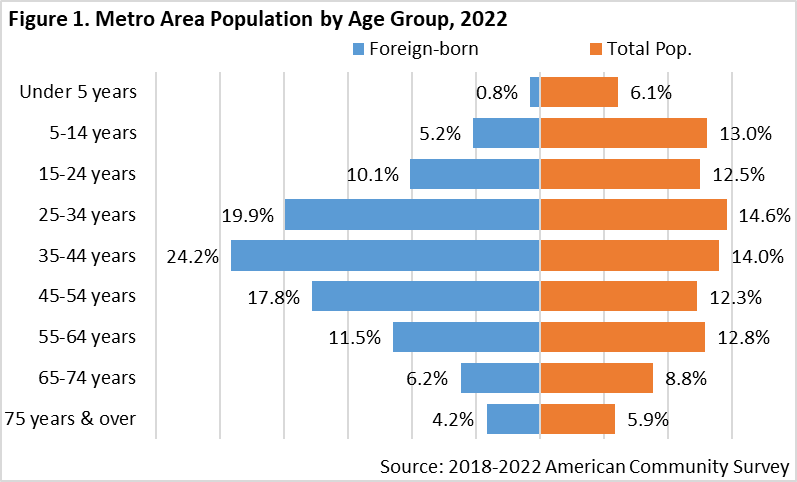 The Minneapolis-St. Paul metropolitan area is a national leader in finance, advanced manufacturing, agriculture and retailing.
The Minneapolis-St. Paul metropolitan area is a national leader in finance, advanced manufacturing, agriculture and retailing.
Medical devices, electronics and processed foods are strong suits recognized globally.
Want the freshest data delivered by email? Subscribe to our regional newsletters.
2/22/2024 9:00:00 AM
Tim O'Neill
The Metro Area's foreign-born population, which includes anyone who is not a U.S. citizen at birth, makes up a vitally important part of the region's total population. This is especially so as the region's total population and labor force continue to age, and as its labor market conditions remain tight. According to the U.S. Census Bureau's American Community Survey (ACS) 5-year estimates, the Metro Area had a total foreign-born population of 377,728 people in 2022. As such, this population accounted for well over one-tenth (12.0%) of the region's total population. Where the Metro Area accounts for a little over half (55.1%) of Minnesota's total population, it accounts for over three-quarters (78.4%) of Minnesota's total foreign-born population.
And this population is growing fast. Between 2010 and 2022, the Metro Area's foreign-born population expanded by 29.3%. This was equivalent to over 85,600 people. For reference, the region's total population expanded by 10.5% during this period. Growth for foreign-born populations in the Metro Area between 2010 and 2022 were especially rapid for those persons reporting origins from central Africa (+185.9%), western Africa (+86.1%), eastern Africa (+81.9%), south central Asia (+64.8%), southern Africa (+58.8%), and western Asia (+57.0%). As of 2022, 39.1% of foreign-born persons in the region reported origins in Asia, 28.8% reported origins in Africa, 22.7% reported origins in the Americas, 9.1% reported origins in Europe, and 0.3% reported origins in Oceania (Table 1).
| Table 1. Place of Birth for the Metro Area's Foreign-Born Population, 2022 | ||||
|---|---|---|---|---|
| Place of Birth | 2022 Population | Change from 2010-2022 | ||
| Number | Percent | Number | Percent | |
| Total, Foreign-born Population | 377,728 | 12.0% | +85,641 | +29.3% |
| Europe: | 34,297 | 9.1% | +657 | +2.0% |
| Northern Europe | 6,310 | 18.4% | +301 | +5.0% |
| Western Europe | 7,074 | 20.6% | +59 | +0.8% |
| Southern Europe | 1,917 | 5.6% | +345 | +21.9% |
| Eastern Europe | 18,924 | 55.2% | -95 | -0.5% |
| Asia: | 147,665 | 39.1% | +33,538 | +29.4% |
| Eastern Asia | 27,653 | 18.7% | +3,653 | +15.2% |
| South Central Asia | 40,384 | 27.3% | +15,883 | +64.8% |
| South Eastern Asia | 72,560 | 49.1% | +11,423 | +18.7% |
| Western Asia | 6,649 | 4.5% | +2,415 | +57.0% |
| Africa: | 108,930 | 28.8% | +47,577 | +77.5% |
| Eastern Africa | 69,356 | 63.7% | +31,226 | +81.9% |
| Middle Africa | 3,456 | 3.2% | +2,247 | +185.9% |
| Northern Africa | 4,062 | 3.7% | +488 | +13.7% |
| Southern Africa | 1,048 | 1.0% | +388 | +58.8% |
| Western Africa | 29,333 | 26.9% | +13,571 | +86.1% |
| Oceania: | 1,210 | 0.3% | +477 | +65.1% |
| Americas: | 85,626 | 22.7% | +3,392 | +4.1% |
| Latin America | 77,754 | 90.8% | +3,301 | +4.4% |
| Northern America | 7,872 | 9.2% | +91 | +1.2% |
| Source: 2018-2022 American Community Survey | ||||
As previously mentioned, foreign-born populations in the Metro Area are helping with tight labor market conditions in the region. This is largely due to the younger age profile for foreign-born persons. In 2022, over three-fifths (61.9%) of the region's foreign-born population reported being between the ages of 25 and 54 years. This age cohort is typically labeled "prime-working age," as persons between 25 and 54 years have the highest labor force participation rates. For reference, only about two-fifths (40.9%) of the region's total population reported being between 25 and 54 years of age. For foreign-born persons moving into and residing in the Metro Area, they are ready, willing, and able to work. Check out The Importance of Immigration reports to learn more about foreign-born populations in the regions and in the state.

DEED's Office of New Americans was recently established to help connect immigrants, refugees and evacuees with employment, among other goals. In addition CareerForce assists foreign-born persons with securing work in the region and state. More information about refugee resettlement can be found with the Minnesota Department of Human Services' (DHS) Refugee Resettlement Programs Office.
Contact Tim O'Neill, Labor Market Analyst, at timothy.oneill@state.mn.us.